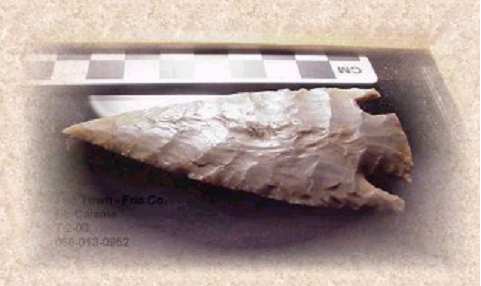

|
By Dr. Thomas Hester This brief article is aptly titled as “notes” since so
little is presently known about the archeology of Medina County. When compared
to adjacent counties along the southern edge of the Edwards Plateau, Bexar
to the east and Uvalde to the west, very little scientific research has
been done in the county . And like these two counties, Medina County
has a very diverse environment ---the “hill country” or Edwards Plateau
to the north, and the coastal plains of south Texas to the south.
Although there are no well documented sites of the Paleoindians, the term used by archeologists to refer to these first occupations, sites in adjacent areas have yielded distinctive spear points such as Clovis (11,500 year ago) and Folsom (10,800 years ago).
Later Paleoindian cultures, using points like Plainview
(10,200 years ago) appeared just as the Ice Age came to an end. For example,
a Plainview point was found some years ago eroding from a steep riverbank
downstream from the present day Medina Dam.
With the onset of the essentially modern climate and vegetation
around 8,000 years ago, ancient American Indian population increased and
spread into all areas of Medina County. At the Jonas Terrace site (41ME
29; 41=Texas; Me= Medina County ; 29=29thdocumented site
recorded in the county ) just off Hwy 16 , archeologists with the Texas
Department of Transportation excavated a large campsite that had been repeatedly
used for more than 45 centuries . Located along the San Geronimo Creek,
the site had numerous cooking hearths, projectile points , and a variety
of debris resulting from it’s repeated occupations over time . This site,
and many like it in Medina County, dates to the Archaic Indians were hunters
and gathers, carefully scheduling their activities and frequent movements
of their camps, based on the availability of certain game or wild plants
in particular regions. Their projectile point (often called “arrowheads”)
tipped spears that were thrown with atlatl (spearthrower). Shapes or the
points changed through time, and these shifts in “types” aid the archaeologist
in dating a culture to a certain time within the Archaic (see Ellen S.
Turner and Thomas R. Hester, 1999,A Field Guide to Stone Artifacts of Texas
Indians. Gulf
Houston). In the northern part of Medina County, campsites
are often marked by dome-shaped accumulations of fire cracked rock and
ash, known as burned rock middens. These result, for the most part, from
the repeated earth oven cooking over several generations. Many of these
sites are dug unscientifically, either as a hobby (“collecting arrowheads”)
or increasingly, for commercial purposes.
Several styles of arrow points were found in Scorpion
Cave, along with bone tools and painted pebbles
These people hunted a wide range of animals, but were
especially adapted across southern and central Texas, to the hunting of
buffalo. In and around the cooking areas at the 41ME34, we found broken
buffalo bone, discarded hide scrapers and knives, and a few fragments of
pottery. This important part of the site has recently been described in
detail in a Master’s thesis written at the University of Houston.
In closing, it can be said that the archaeology of Medina County is essentially untapped. Little is known, less than 120 sites have been recorded (though it is clear that there are thousands of them), and urban expansion, normal farming and ranching activities, housing developments, and, especially, undocumented relic-collecting takes a toll on sites every day. Fortunately, organizations like the Southern Texas Archaeological Association (headquartered in San Antonio) have carried out field schools, scientifically investigating and publishing (in their journal, La Tierra) a number of prehistoric sites in the Medina River Valley. If you are interested in sharing information on the Medina County area, contact the STAA at P.O. Box 791032, San Antonio, Texas, 78279; or your local Texas Historical Commission Steward, David Calame, Sr. , P.O. Box 448 Devine, Texas 78016 ; or the Texas Archeological Research Laboratory, PRC 5, The University of Texas at Austin, Austin, Texas 78712-1100. At UT’s laboratory, site locations will be kept confidential upon request and are not subject to the Open Records Act. Contrary to wide spread rumors, archaeologists respect
private property rights and confidentiality – and we do not “seize” or
“confiscate” collections or the land on which sites are located!
Thomas R. Hester, PhD. Director, Texas Archeological
Research Laboratory, and Professor of Anthropology The University of Texas
at Austin.
|
| Home | Gallery | Latest Finds | Editorials Index |